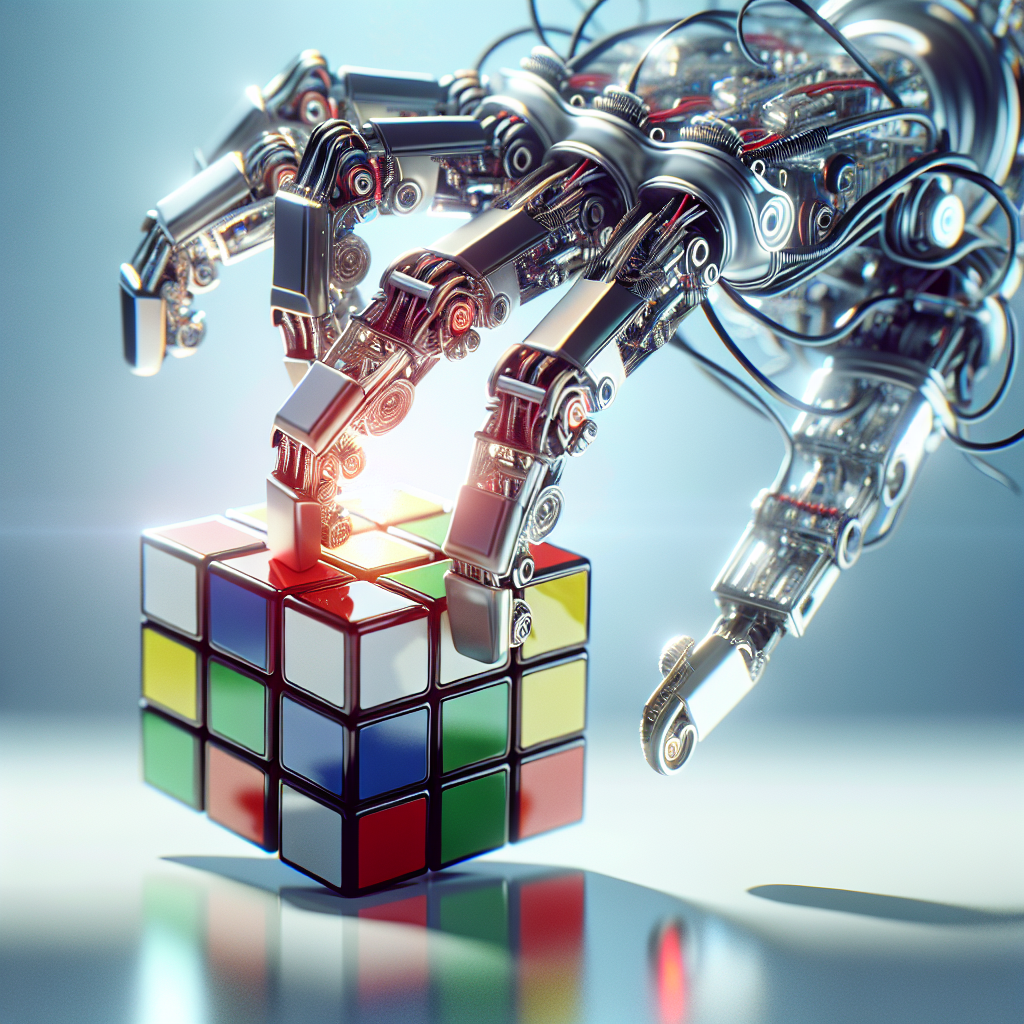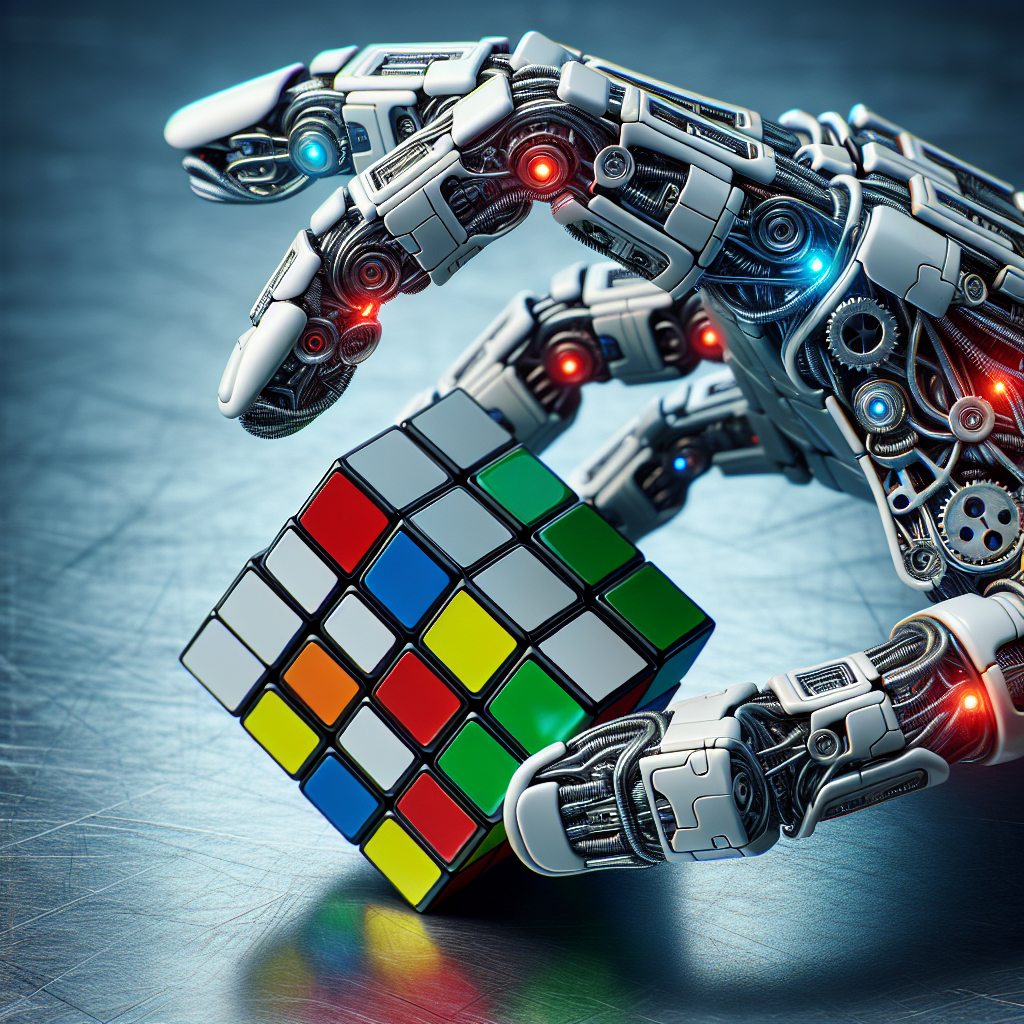-
Table of Contents
The challenge of solving a Rubik’s Cube, a 3D combination puzzle invented in 1974 by Ernő Rubik, has fascinated both humans and machines for decades. In recent years, the development of robotic systems capable of solving this puzzle has emerged as a significant area of research in robotics and artificial intelligence. Solving a Rubik’s Cube with a robot hand involves complex problem-solving algorithms, precise mechanical movements, and advanced sensory inputs. This task not only showcases the robot’s dexterity and cognitive capabilities but also serves as a benchmark for advancements in robotics, demonstrating the integration of mechanical engineering, computer vision, and artificial intelligence. The endeavor to create a robot hand capable of solving the cube pushes the boundaries of what is technically possible, offering insights into the future of robotics and AI applications in real-world scenarios.
Designing a Robot Hand for Efficient Rubik’s Cube Solving

In the realm of robotics and artificial intelligence, the Rubik’s Cube stands as a benchmark challenge, testing the limits of dexterity, speed, and problem-solving capabilities. The task of designing a robot hand capable of efficiently solving this puzzle encapsulates a fascinating intersection of mechanical engineering, computer science, and cognitive psychology. This endeavor not only pushes the boundaries of what robots can achieve but also offers profound insights into the nature of human intelligence and manual dexterity.
The initial step in this ambitious project involves the meticulous design of the robot hand itself. Engineers and roboticists must ensure that the hand mimics the flexibility and range of motion found in human fingers. Achieving this level of dexterity requires a sophisticated understanding of biomechanics, as well as advancements in materials science to develop joints and appendages that can delicately manipulate the cube without sacrificing speed or precision. The integration of tactile sensors further enhances the hand’s ability to gauge the force necessary to twist the cube’s segments without dislodging them, a task that demands a delicate balance.
Beyond the physical construction of the robot hand, the challenge extends into the realm of artificial intelligence and algorithmic problem-solving. The robot must be equipped with a vision system capable of recognizing the cube’s current state and identifying the most efficient series of moves to reach the solution. This involves the implementation of complex algorithms that can calculate permutations and predict outcomes with astonishing speed. The marriage of hardware and software in this context is a testament to the interdisciplinary nature of robotics, requiring seamless collaboration between mechanical engineers, computer scientists, and AI specialists.
Furthermore, the process of teaching the robot hand to solve the Rubik’s Cube transcends mere programming; it involves a deep understanding of the cognitive strategies employed by human experts. This aspect of the project highlights the importance of cognitive psychology in robotics, as developers strive to encode strategies and heuristics into the robot’s decision-making processes. By analyzing the techniques used by human solvers, researchers can program the robot to recognize patterns and apply logical deductions, thereby optimizing its problem-solving approach.
The endeavor to create a robot hand capable of solving the Rubik’s Cube also has broader implications for the field of robotics. Success in this area could pave the way for advancements in robotic dexterity that are applicable to a wide range of tasks, from assembly line work to surgical procedures. The precision and adaptability required to solve the cube mirror the skills needed in these contexts, making the project a valuable proving ground for future innovations.
In conclusion, designing a robot hand for efficient Rubik’s Cube solving is a multifaceted challenge that encapsulates the cutting edge of robotics and artificial intelligence. It requires a harmonious blend of mechanical design, algorithmic problem-solving, and cognitive insight, making it a quintessential example of interdisciplinary collaboration. As researchers continue to push the boundaries of what robots can achieve, the lessons learned from this endeavor will undoubtedly influence the future trajectory of robotics, opening new avenues for exploration and application in an increasingly automated world.
Programming Challenges in Creating a Rubik’s Cube-Solving Robot Hand
Solving a Rubik’s Cube, a puzzle that has captivated minds since its invention in the 1970s, is no small feat for humans, let alone for a robot. Yet, the advent of robotics and artificial intelligence has brought us to a point where creating a robot hand capable of solving this puzzle is within the realm of possibility. This endeavor, however, is fraught with programming challenges that push the boundaries of current technology and require innovative solutions.
One of the primary challenges in programming a robot hand to solve a Rubik’s Cube lies in the realm of perception. For a human, recognizing the colors and the configuration of the cube is intuitive, but for a robot, this task necessitates the integration of advanced computer vision technologies. The robot must be equipped with cameras and sensors that can accurately identify each of the cube’s six colors in various lighting conditions. Moreover, the system must be capable of determining the orientation of the cube and the position of each piece in real-time, a task that involves complex algorithms and significant computational resources.
Following the perception hurdle, the next challenge is the development of an efficient solving algorithm. While numerous algorithms exist for humans to solve a Rubik’s Cube, translating these methods into instructions a robot can follow is a complex task. The robot’s software must not only incorporate the algorithm but also adapt it based on the cube’s current state, which it continuously receives from its sensory inputs. This requires a dynamic programming approach that can handle a vast number of cube configurations and find the most efficient solution in terms of the number of moves and the time required.
Furthermore, the physical manipulation of the cube introduces another layer of complexity. The robot hand must be able to execute the precise movements needed to rotate the cube’s faces without dropping it. This challenge encompasses both the mechanical design of the hand, which must mimic the dexterity of a human hand, and the programming of the motor controls to achieve smooth and accurate movements. The software must coordinate the actions of multiple motors and joints, ensuring they work in harmony to replicate the specific twists and turns needed to solve the puzzle.
Additionally, the integration of these components into a cohesive system presents its own set of challenges. The software must seamlessly combine the inputs from the vision system, the solving algorithm, and the motor controls to guide the robot’s actions. This integration requires a high level of synchronization and real-time processing to ensure that the robot can adjust its strategy as it progresses, making corrections as necessary.
In conclusion, programming a robot hand to solve a Rubik’s Cube is a multifaceted challenge that encompasses computer vision, algorithm development, motor control, and system integration. Each of these areas presents unique obstacles that must be overcome through innovative programming and engineering solutions. Despite these challenges, the pursuit of creating such a robot hand pushes the boundaries of what is possible in robotics and artificial intelligence, offering valuable insights and advancements that extend far beyond the confines of a puzzle-solving machine.
Comparing Performance: Human vs. Robot in Solving Rubik’s Cube
Title: Solving Rubik’s Cube with a Robot Hand
The Rubik’s Cube, a seemingly simple yet profoundly complex puzzle, has fascinated enthusiasts and challengers alike since its inception in the 1970s. It is not just a test of spatial awareness and problem-solving skills but also a benchmark for speed and efficiency in pattern recognition and execution. Over the years, the quest to solve the Rubik’s Cube has transcended human endeavor, entering the realm of robotics and artificial intelligence. This exploration into the comparative performance of humans and robots in solving the Rubik’s Cube reveals not only the advancements in robotics but also sheds light on the nuances of human intelligence and dexterity.
Humans have long been at the forefront of Rubik’s Cube competitions, with speedcubers continually breaking records through a combination of memorized algorithms, quick reflexes, and hours of practice. The current human world record for solving a standard 3×3 Rubik’s Cube stands impressively at just under 4 seconds. This achievement underscores the remarkable capabilities of the human brain in pattern recognition, spatial reasoning, and motor coordination. Speedcubers often rely on a method known as CFOP (Cross, F2L, OLL, PLL), breaking down the cube’s solution into manageable steps and executing them with lightning-fast precision.
In contrast, the domain of robotics has approached the challenge of the Rubik’s Cube from a different angle. Robots designed to solve the Rubik’s Cube, such as those equipped with a robot hand, leverage the power of algorithms, sensors, and mechanical precision. These machines analyze the cube’s current state through cameras or sensors, compute the most efficient solution using advanced algorithms, and execute the moves with a precision and speed unattainable by human hands. Remarkably, a robot equipped with a sophisticated robotic hand and powered by artificial intelligence algorithms has shattered previous records by solving the cube in a fraction of the time it takes a human, with the current robotic record standing at well below one second.
This stark difference in solving times between humans and robots highlights the contrasting strengths of each. Robots excel in consistency, speed, and precision, executing pre-determined algorithms without error or hesitation. Their ability to process and react to the cube’s configuration in real-time demonstrates the power of artificial intelligence in pattern recognition and problem-solving. On the other hand, human solvers bring creativity, adaptability, and the ability to learn and improve through practice and experience. While robots follow a set of programmed instructions, humans can adapt their strategy on the fly, learning from each attempt and sometimes even solving the cube in ways that are unique or unconventional.
The comparison between human and robot performance in solving the Rubik’s Cube also offers insights into the broader implications of robotics and artificial intelligence in our lives. It underscores the potential for machines to assist or even surpass human abilities in specific tasks, while also highlighting the unique aspects of human intelligence that are difficult to replicate in machines. As technology continues to advance, the collaboration between human ingenuity and robotic precision could lead to even greater achievements, not only in solving puzzles like the Rubik’s Cube but in addressing complex challenges across various fields.
In conclusion, the journey of solving the Rubik’s Cube, from human hands to robotic ones, encapsulates the evolving relationship between humans and machines. While robots have demonstrated superior speed and precision, the human approach to solving the cube embodies creativity, adaptability, and the spirit of challenge. This comparison not only celebrates the achievements in robotics and artificial intelligence but also serves as a reminder of the unique strengths and potential of human intelligence.

